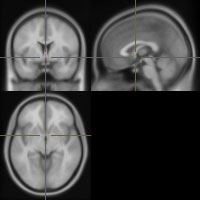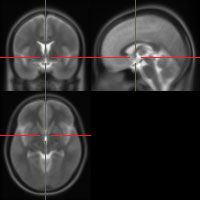The Commissures
What are they?
The commissures are fibre tracts connecting the two hemispheres. There is a posterior commissure, which connects midbrain and diencephalon structures, and lies just in front of and above the superior colliculi, below the pineal gland. The posterior commissure is not always easy to see on a high detailed structural scan, and it is very unlikely you will be able to discern it on functional images.The anterior commissure (AC) connects the middle and inferior temporal gyri of the two hemispheres, and runs across the midline just in front of the fornix. It is relatively easy to see on most structural scans.
Why the commissures?
The commissure have become key landmarks, because Talairach and Tournoux chose them to determine the standard alignment of the brain for their famous atlas. To align a scan to Talairach space, a brain has to be set so that the anterior and posterior commissures are on a horizonatal line.
Where are they?
Below is a little schematic (from Chris Rorden's MriCro tutorial) of a sagittal brain view. The anterior commissure is shown in red, and the posterior commissure in yellow. 
The image below shows the anterior commissure on an iconic brain from the MNI series (see the MNI space page for details). The AC is at the virtual intersection of the red lines.

The AC is best seen on slice 91 in X, 131 in Y and 67 in Z of the iconic brain image.
Below is an image showing the PC on the same brain, again at the (truncated) intersection of the red lines. The PC can best be seen at slices X 91, Y 103 and Z 70. Note that this brain is not exactly oriented according to the Talairach system, as the two commissures are not on the same axial plane.

It may be useful to scroll through the iconic brain image provided with MRIcro or MRIcroGL, to get used to the landmarks around the commissures.
Here is the position of the anterior commissure on the MNI 152 average brain; first on the the T1 average:

and next on the T2 average (which is more similar to EPI images).

Specifying the commissures on low resolution images, such as functional images, requires a little guesswork, combined with a knowledge of where the commissures are in relation to anatomy that you can see, such as the thalamus, brainstem, and corpus callosum.
Matthew Brett, Chris Rorden 17/12/99
References
J. Talairach and P. Tournoux, "Co-planar Stereotaxic Atlas of the Human Brain: 3-Dimensional Proportional System - an Approach to Cerebral Imaging", Thieme Medical Publishers, New York, NY, 1988
H.M. Duvernoy, "The Human Brain: Surface, Blood Supply, and Three Dimensional Sectional Anatomy", second edition, Springer, Vienna, 1999
